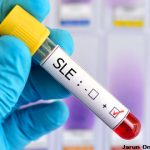In my opinion, the indications for ordering an anti-Ro/SSA and anti-La/SSB antibody tests are as follows:
- Women with SLE who are pregnant or may become pregnant in the future;
- Women who have a history of giving birth to a child with heart block or myocarditis;
- Patients with a history of unexplained photosensitive skin eruptions;
- Patients strongly suspected of having SLE but who have a negative ANA test; or
- Patients with symptoms of xerostomia, keratoconjunctivitis sicca, and/or salivary and lacrimal gland enlargement.
Antiribosomal P Protein Antibodies
Anti-ribosomal P protein antibodies have been detected in 10% to 20% of patients with SLE in the United States and 40% to 50% of Asian patients with SLE, but rarely in other rheumatic diseases.30 Anti-ribosomal P protein antibodies may be highly specific for lupus-associated psychosis, although not all studies have confirmed this. Depression and renal and liver involvement in patients with lupus have also been associated with anti-ribosomal P protein antibodies in some small studies.
Because of the low sensitivity and poor clinical correlation, many investigators—including myself—see little clinical usefulness in this test.
Anti-Centromere Antibodies
Anti-centromere antibodies (ACAs) are found almost exclusively in patients with limited cutaneous systemic sclerosis (lcSSc) especially in those with CREST.31 ACAs have been observed in 57% of patients with CREST but have also been seen in patients with other conditions, including in some patients with Raynaud’s phenomenon alone. ACAs are typically detected by the characteristic IF pattern on Hep-2 cells.
Anti–Scl-70 (topoisomerase-1) Antibodies
Approximately 15% to 20% of patients with scleroderma have antibodies to a 70kd protein (topoisomerase-1), subsequently named Scl-70.31 The usual method for detection is by ELISA. The presence of these antibodies appears to increase the risk for pulmonary fibrosis among patients with scleroderma and is quite specific for the disease.
Summary
If one suspects SLE based on the history, physical examination, and complete blood count (e.g., leucopenia, thrombocytopenia), request an ANA test. If it is negative, it is highly unlikely that the patient has SLE, and the patient can be reassured. If the titer is <1:160, SLE is unlikely, and the patient can be reassured that SLE is unlikely, but the patient should be followed periodically. A titer of ≥1:160 increases the likelihood of SLE and related disorders. However, it is important to remember that 85% of individuals with a positive ANA do not have SLE. If the ANA is positive, one should also test for antibodies to dsDNA, Sm, RNP, Ro/SSA, and La/SSB. The presence of these antibodies greatly increases the likelihood that the patient has SLE and related disorders (see Table 2, p. 17), and the patient needs to be followed more closely. The detection of anti-centromere and anti–Scl-70 antibodies is very useful for the diagnosis of scleroderma. The detection of antibodies to Ro/SSA and La/SSB are also useful for the diagnosis of Sjögren’s syndrome.

